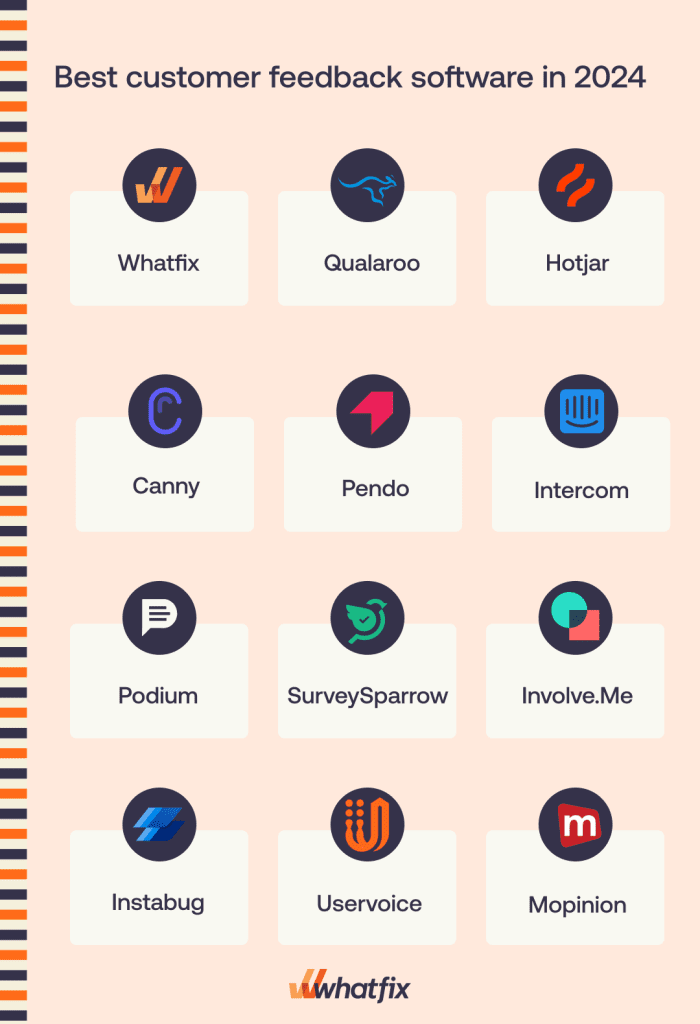
Andrew Dennis


Building SaaS products and digital services is challenging.
What’s harder? Trying to find a product-market fit, getting customers to stick, reducing churn, and continuously iterating on your product to make it solve your users’ problems. How do you reliably keep track of the challenges your users expect your product to solve and how well it does so?
That’s where customer feedback comes into play. Customer feedback tools help you engage your users 1:1 and at scale to understand if and how much they appreciate what you offer, and how to improve the experience.
This article explores customer feedback software, the different types of customer feedback tools, why you need them, and the best customer feedback tools for you to consider when buying a third-party SaaS platform.
Customer feedback tools are designed to help product teams get an unfiltered view of their user’s interactions with their product(s) and learn what their customers think, especially what works and what doesn’t. These tools help you engage your customers at scale with surveys, forms, ratings, comments, and community conversations to what they like about your product/service and what needs more work.
There are four main types of SaaS customer feedback tools, including:
Like their name implies, in-app feedback tools are programmed to inject in-app surveys into the application experience, both on web and mobile. You can use conditional logic to trigger them after users complete specific milestones.
Traditional survey tools (Momentive, Jotform, Typeform, etc.) are used to engage customers in basic Q&A quizzes that they can answer via text, a metric scale (On a scale of 1 to 10…), or other gimmicks, such as emojis, etc.
Review management platforms are usually integrated with mainstream customer review channels (e.g., G2, Google Business, Facebook, Yelp, etc.) so that customers can leave reviews that reflect on those platforms in a few steps. They also double as reputation management suites for disputing hurtful, dishonest reviews and having them unpublished.
Sentiment analysis tools use AI and machine learning to interpret the essence of large quantities of customer reviews, messages, and notes. The goal is to find common threads through all the data collected so you can focus on the most pressing issues that are raised repeatedly instead of working on every minor ticket raised.
The most important benefit customer feedback software offers is data—this includes ratings, sentiments from reviews, comments, surveys, etc. Processing that data, in turn, helps you to determine what direction your product needs to take and how much value your customers are getting out of it (and consequently how much they’ll be willing to pay).
We’ve highlighted the best customer feedback software, including a breakdown of each platform’s core offerings, key features, price, and review rating.
For this list, we’ve excluded traditional, generic survey tools (like SurveyMonkey and JotForm) and review generation and management tools (TrustPilot) – the following customer feedback tools are comprehensive platforms that enable companies to create and embed in-app surveys into their products, collect and analyze end-user events and behavior, and manage customer feedback with built-in offerings or native integrations.


Whatfix is a digital adoption platform designed to help product teams simplify software experience and drive adoption through in-app guidance and real-time support. But, Whatfix takes it further with a feedback loop that enables you to understand how your users feel about your product’s UX, down to specific features. For instance, you can embed in-app surveys at specific touchpoints or program them to trigger after a customer fulfills a specific condition (using if-then workflows).
Whatfix’s feedback forms and surveys support a wide range of options, including NPS measurements, custom rating scales (1-5 stars, 1-7, etc.), free text options, emoji reactions, etc. Finally, all that data gets funneled into intuitive dashboards and integrated with our end-user analytics suite. You can analyze user behavior by cohorts or any other variables to help you find helpful trends.
With Whatfix, analyze your end-user engagement to identify areas of friction with behavior analytics and in-app surveys. Then, use in-app guided elements like Self Help, Task Lists, Smart Tips, Field Validations, Flows, and more to overcome these friction areas to create contextual, optimized end-user experiences.

Qualaroo is a full-stack customer feedback platform that’s basically a survey tool on steroids. Here’s why: Qualaroo offers 20+ different question types (checkboxes, text fields, dropdown, radio buttons, matrixes, dates, etc.), accepts file uploads and lets you import surveys in bulk from an existing database.
Beyond the basics, Qualaroo offers a no-code sequence builder, AI-powered sentiment analysis, advanced targeting for segmenting your user base, text analytics, NPS surveys, etc. And Qualaroo’s survey feature lets you use if-then logic to customize the questions specific users see (based on prior answers) branching to narrow down the options users are offered.

Coming from Qualaroo, we have to first note that Hotjar isn’t a customer feedback platform in the same sense—it’s more of a product analytics tool that helps you observe user sentiment, individually and at scale if you prefer. The core of Hotjar’s suite of tools includes:

Canny is a customer feedback platform for software products with a community-first ethos: in other words, Reddit for product teams. On Canny, your users (with your team pitching in or moderating) can raise tickets, discuss issues, ask other customers for help, keep tabs on your product roadmap, and vote product priorities. Canny integrates with your existing customer service/product management stack, with connectors built for Jira, Intercom, Zendesk, Slack, etc.

Pendo is another option that’s solidly in the product experience/analytics camp with tools like session replays that essentially gets you looking over your users’ shoulders, as well a roadmapping feature where you can share planned features or changes, explain the context around them, and essentially build in public. But Pendo’s main customer feedback feature is their Feedback product offers AI-generated response summaries, automatic updates on customer requests/product backlog items, and integrations with the rest of your stack (Workfront, Jira, etc.).
You can also add the Pendo Feedback widget to your help resources (wiki, docs, etc.) pages so you can understand if/how much your self-help resources are serving your customers.

Like several of the options on our list, Intercom wasn’t designed primarily as a “customer feedback platform” per se—in its simplest form, it’s basically a live chat tool—but as the product’s scope and features have grown, it’s become a good contender in that niche.
In that capacity, Intercom has several tools under its belt, including powerful multi-channel surveys (mobile, web, etc.), if-then sequences that customizes what each customer (in the survey pipeline) sees, lead funnels for capturing potential customers’ info at the point of inquiry, and detailed reporting. At its center is a flexible, no-code composer for customizing the feedback experience, down the colors, rating scales, and greetings without writing any code.

Podium is more of an all-in-one software kit designed to help service businesses (retail, health & wellness, automotive, etc.) get and retain more customers. Apart from the core functionality that revolves around closing customers via text messaging/support/payments, one of the ways they do that is through a combination of online reviews, multi-channel surveys, and live chat—all of which double as customer feedback channels.
Podium’s survey feature enables customers to share feedback and ratings via a conversational format, while the reviews feature nudges via text them to share a review to your preferred channels (Google, Facebook, TripAdvisor, etc.), all on autopilot.

In its own words, SurveySparrow is an omnichannel experience management platform—basically, their entire product is dedicated to customer feedback through and through, and no matter the level of functionality you want, SurveySparrow can help.
Among others, SurveySparrow enables businesses to:

Involve is an online form builder with a flexible core, which makes it easy to adapt for marketing and growth use cases. Specifically, Involve offers NPS surveys that you can customize to fit your needs, down to the visual elements, rating scales, integrations with the rest of your tools, and if-then sequences with branching logic.
On the other hand, their survey maker lets you use logic jumps (to guide users to different pages & questions depending on what they answer), data validation, email confirmations/summaries, custom formulas (with conditional logic), and AI-powered analytics to customize your surveys, no matter how large your customer base is.

Instabug is a user feedback platform for mobile applications—whether your application is native to iOS, Android, or built with a cross-platform solution like Flutter, Xamarin, or Cordova. And, speaking of feedback, Instabug makes it easy for users to report anything easily: for instance, users can shake their device to report a bug, while in the backend, Instabug shows you a network logs, optional session replays, and a chart of all the steps user made before encountering an issue (so you can reproduce).
Add to that crash reports, performance monitoring, and app store monitoring (trying to find patterns in reviews and ratings) and you get a better picture of how Instabug works.

UserVoice is a product discovery platform designed with growing software/growth teams in mind. UV enables you to collect feedback via multiple channels, validate product decisions with customer surveys, and ultimately serves as a forum of sorts for managing your product roadmap in full view of your users—where they can suggest and upvote priorities, and where you can attach a dollar value to roadmap items.

Mopinion is an all-in-one feedback platform for digital channels—think websites, applications, email, etc. Mopinion helps you track a wider range of customer/user engagement metrics including your Customer Satisfaction Score, Customer Effort Score, NPS, etc. Mopinion also offers conversational surveys that you can interact with in natural language, combined with a visual design interface that lets you drag-and-drop elements into place.

Forms.app is an online form building to enable organizations to build custom forms, collect user feedback, automate workflows, and embed feedback forms in web-app experiences. Its customization features empower companies to create on-brand forms, and its embedding features allow companies to add the forms to any browser-based app or website.
Whatfix is an all-in-one guidance and digital adoption platform that enables end-users with contextual assistance and user support. With Whatfix, create contextual in-app guidance for different types of end-users with its Visual Editor, a no-code editor to create and launch in-app content, while meeting your brand standards.

Create Tours and Task Lists for new user onboarding, Flows to drive adoption of complex features or processes, and Beacons to highlight under-adopted features or UI changes. Enable end-users with Self Help that provides an embedded resource center in your application’s UI and Smart Tips to provide performance support in dropoff areas in moments of need.

Analyze your end-user behavior with Whatfix Analytics to understand how users engage with your application, build user cohorts based on behavior patterns, map optimal user journeys, conduct cohort analysis, and identify areas of user friction. Address and overcome friction areas in your user flows with additional in-app guidance and support content at these dropoff areas.
Looking to understand your customers better? With Whatfix’s no-code editor create in-app contextual surveys, polls, and questionnaires inside your application’s UI – along with additional in-app guidance, on-demand support, and end-user analytics.
Request a demo to learn how Whatfix can help you enable end-users, collect feedback, and use data to build better product experiences.

Thank you for subscribing!